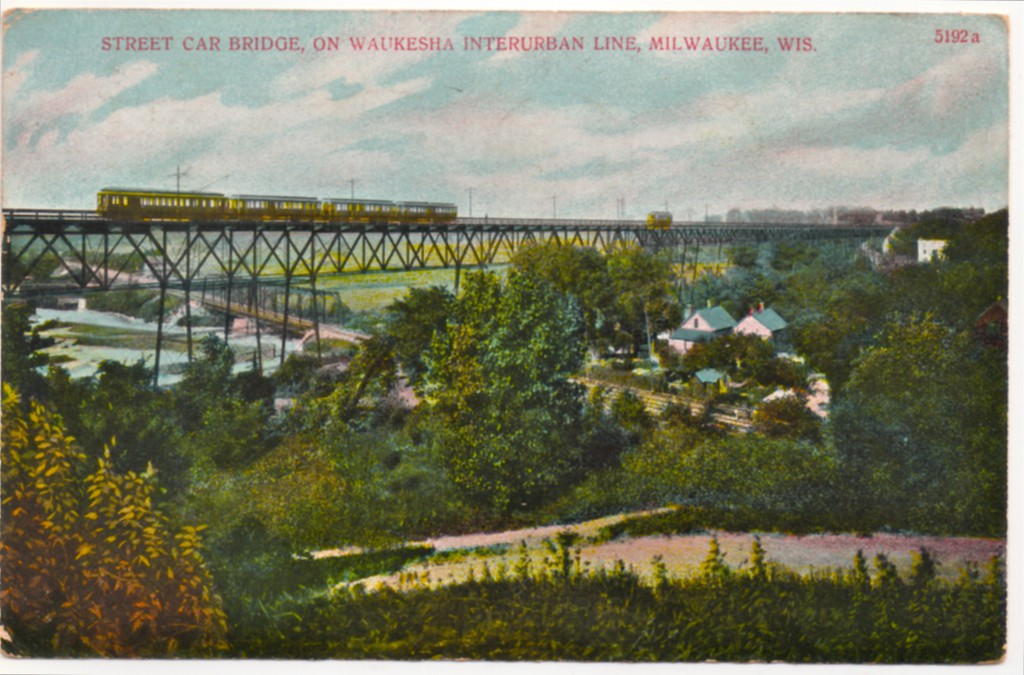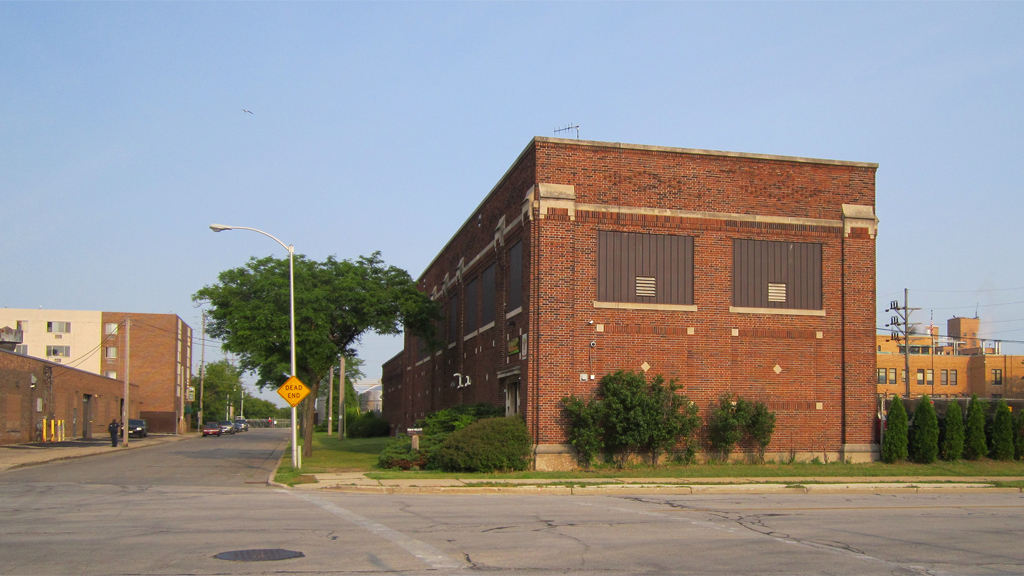
Enjoy this sample chapter from the book, Lost Milwaukee, by Carl Swanson, published by the History Press.
Nothing remains today, but for 60 years, the Wells Street viaduct was a Milwaukee landmark and the single greatest engineering achievement of the city’s once-vast streetcar and interurban empire.
As a thrill ride, albeit an unintentional one, the viaduct had few equals – especially when high winds buffeted the cars. Even veteran riders felt apprehensive as their streetcars rattled and swayed across the rickety-looking 2,085-foot-long bridge, 90 feet above the Menomonee River valley.

The Milwaukee & Wauwatosa Motor Railway Co. was formed in the 1890s to build and operate a three-mile-line between the intersection of North 36th and West Wells streets and West Main Street in Wauwatosa, along with a two-mile branch into West Allis. The Motor Railway awarded a contract in 1892 to construct the viaduct across the wide Menomonee Valley.
Although 1.3 million pounds of steel and a half-million pounds of timber went into its construction, many Milwaukeeans thought the bridge looked ridiculously flimsy. In fact, its Victorian-era designer, Gustave Steinhagen, relied on excellent engineering rather than overwhelming mass. His bridge was amply strong enough to accommodate even very heavy four-car electric interurban trains.
Built wide enough for two railroad tracks, the bridge opened with a single track and a one-lane toll road for pedestrians and wagons. The bridge was soon double-tracked, and the Motor Railway became part of the Milwaukee Street Railway Co. In 1897, the Street Railway and the several other privately owned lines merged to form the Milwaukee Electric Railway & Light Co.
Although the names of its owners changed, the giant bridge was always kept in good repair. In 1927, the structure was extensively rebuilt. Heavy plate girder sections replaced the original 60-foot-long truss spans. Supporting piers were also reinforced. The work resulted in state regulators approving an increase in the viaduct’s speed limit from 15 mph to 25 mph.
In 1938, Wisconsin Electric Power Co. took over operation of what was simply known as The Electric Co., which, in turn, operated streetcars under a subsidiary called, logically, The Transport Co.
Thanks to careful maintenance and cautious operation (for a time, signs at both ends of the bridge sternly reminded motormen they were forbidden to cross the valley in less than two minutes), there was never an accident on the viaduct, not even a minor derailment.
Certainly there were plenty of odd occurrences. The viaduct seemed to have an almost hypnotic appeal for drunken drivers. On several occasions inebriated motorists attempted to drive across the viaduct. Generally these adventures ended quickly and their broken vehicles had to be towed away before streetcar service could resume. On at least two occasions intrepid – and almost certainly stewed-to-the-gills – drivers made it all the way across, their cars bouncing along from one tie to the next high above the valley leaving a trail of shredded tire pieces for railroad workers to find the next morning.
On the night of June 7, 1946, a streetcar motorman spotted a fire in the 13-acre Hilty-Foster Lumber Co. yard located under the viaduct. He notified his dispatcher, who called the fire department.
The fire, possibly caused by an explosion of stored benzine, was already out of control when the first firefighters arrived and the blaze quickly grew into a five-alarm inferno destroying 4 million board feet of lumber, a box shop, planning mill, two warehouses, four lumber sheds, and 18 boxcars. Twenty-one fire engine companies and eight ladder trucks – more than half the city’s fire equipment – fought the fire.
Surrounded and at times almost hidden by swirling flames, the viaduct’s wooden deck soon ignited and, after burning for hours, collapsed into the valley below. Streams of water played on the burning bridge caused the super-heated steel to warp and twist. Service was suspended for five days while an army of workers from the Transport Co.’s Way and Structures Department repaired the damage.
The Transport Co. completed the change to buses in late 1957, but streetcars continued to serve the Wells Street line into early 1958. It was a temporary reprieve caused by uncertainty over the continued control of the viaduct. The wording of the original property easements clearly specified the viaduct was for streetcar use. Realizing the legal justification for the viaduct’s existence ended the instant the last streetcar rumbled across, the company kept the Wells line going a few additional months while it pondered its options.
The Menomonee Valley was a major bottleneck for east-west traffic in the years before the freeway system. Running transit buses over a rebuilt viaduct seemed an appealing option for a time, but nothing came of it.
Finally, on March 2, 1958, the Wells cars made their final runs. The viaduct remained in place for a few years while the city considered a plan to covert it into a vehicular bridge for a proposed east-west highway. The completion of the Interstate ended this idea and bridge was dismantled in 1961-62.
Carl Swanson is the author of the book Lost Milwaukee from The History Press, available from book stores or online.




Great article Carl !
I did get to ride the streetcars a few times with my Grandma, but I sure wish that
I could have made the trip across this bridge when I was little !
LikeLiked by 1 person
Very interesting and well-researched article. Love the postcards of the trestle. I had always thought Milwaukee was flat–that Menominee is quite the valley. I still own my grandfathers’ WEC stock — would have loved to see that spindly bridge before they tore it down but alas I was only two at the time. Thanks for another great story, Carl!
LikeLiked by 1 person
Great story Carl. Thank You 🙂
LikeLike
I rode it many times and loved it. When on the trestle, my brothers and I would go to the end where the conducted wasn’t and ring the bell on the floor. He was not amused.
LikeLike
Gustave Steinhagen was a my great great grandfather! I live very close to his old house on State St.
LikeLike